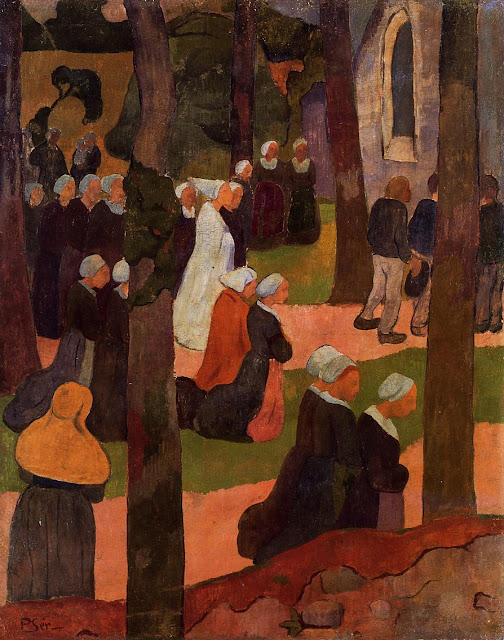Paul Sérusier (1864 – 1927) was a French painter who was a pioneer of abstract art and an inspiration for the avant-garde Nabi movement, Synthetism and Cloisonnism. Sérusier was born in Paris into a well-to-do middle-class family. His father was a successful businessman in the perfume industry.
In 1885, after a short period of work in the company of his father's friend, Paul entered the Académie Julian to study art. His lifelong friendship with Maurice Denis started there. In 1888, Sérusier arrived at Pont-Aven in Brittany, a town popular among French and foreign artists. There Sérusier's attention was attracted by a group of artists who crowded around Emile Bernand and Paul Gauguin. Gauguin encouraged the young painter to release himself from the constraints of imitative painting, to use pure colours, not to hesitate to exaggerate his impressions, and to give to the painting his own decorative logic and symbolic system.
Sérusier returned to Paris with a small painting, drawn under Gauguin's guidance, and showed it enthusiastically to his friends, sharing the new ideas that he learned from Gauguin. They called the painting The Talisman.
 |
| 1888 The Talisman, the Aven River at the Bois d’Amour oil on canvas © photo musée d'Orsay / rmn |
In the summer of 1892 Sérusier returned to Brittany, to the small village Huelgoat. Huelgoat became the place of his work for the next two years. His subjects were Breton peasants, their figures monumental and solid. The painter's palette too had changed, he no longer used pure colours, but toned them down with grey.
Sérusier spent his winters in Paris, working with his friend Lugné-Poe, founder of Théâtre de l'Oeuvre. Many of the Nabis artists participated in the scene decoration and costume design of the Symbolist plays of the theater, Sérusier among them. The theatre made it possible for them to try out on a large scale their principles of simplification and the synthesis of the various means of expression.
In 1895, Sérusier accepted an invitation of his friend Jan Verkade, to go to the Benedictine monastery of Beuron in Germany. The monk-artists of the monastery practiced the aesthetic principles, according to which the laws of beauty were divine ones; they were mysteriously hidden in nature and could be revealed only to the artists who were able to perceive the proportions and the harmony of the sizes. The new doctrines appealed to Sérusier, and on his return to Paris he tried to convince his Nabi friends in their novelty and importance. The ideas met no enthusiasm in Paris and Sérusier distanced himself from his former friends. After several successive voyages to Beuron, he settled in Brittany and cultivated painting primarily based on calculations and measurements. He applied Beuron ideas to his Breton subjects. Then he studied Egyptian art, the Italian primitivists, and the tapestries of the Middle Ages.
From 1908, he started to teach regularly at the Ranson Academy. In 1921 Sérusier published "ABC of Painting", a short treatise in which he developed a theory of the curves and simple shapes, and a theory of colour and a method of research of the deafened colours. The book represented the summary of Sérusier's aesthetic research. He died in 1927 in Morlaix. This is a two-part post on the works of Paul Sérusier, part two will show more works.
 |
| n.d. Avenue de Neuilly oil on board |
 |
| 1889 Bretonne donnant à manger aux cochons tempera on canvas © photo musée d'Orsay / rmn |
 |
| 1889 La barrière fleurie, Le Pouldu oil on canvas © photo musée d'Orsay / rmn |
 |
| c1889-90 The Sea at Poldu, Sunset oil on canvas |
 |
| 1890 A Bretonne Sunday oil on canvas |
 |
| 1890 Farmhouse at Le Pouldu oil on canvas |
 |
| 1890 Fisherman on the Laita oil on board |
 |
| 1890 Mother and Child on a Breton Landscape oil on canvas |
 |
| 1890 Two Breton Women under a Flowering Apple Tree oil on canvas |
 |
| 1890 Yellow Farm at Pouldu |
 |
| 1891 Square with Street Lamp oil on canvas |
 |
| 1891 Woman in a Street oil on canvas |
 |
| c1891-93 Breton Women, the Meeting in the Sacred Grove oil on canvas |
 |
| c1891 Eve Bretonne ou M´lancolie oil on canvas |
 |
| c1891 Plate of Apples oil on canvas |
 |
| 1892 La Couseuse oil on canvas |
 |
| 1892 Les Laveuses à la Laïta oil on canvas |
 |
| 1892 Madeline with the Offering oil on canvas |
 |
| 1892 The Ile de la Douane, the Mouth of the Trieux River watercolour |
 |
| 1893 Bretons in the Forest of Huelgoat oil on canvas |
No comments:
Post a Comment
Note: only a member of this blog may post a comment.